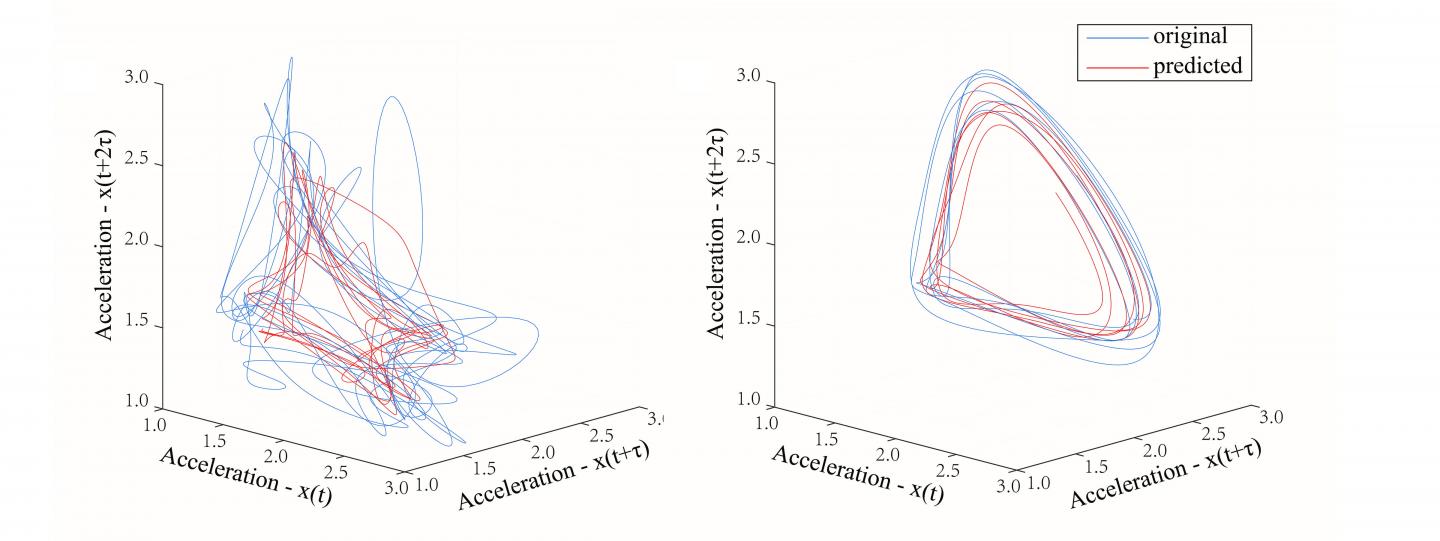As the most common form of the disease, early diagnosis of Duchenne muscular dystrophy is key to survival

Credit: Image courtesy of the authors
WASHINGTON, February 11, 2020 — Duchenne muscular dystrophy is the most common type of muscular dystrophy, affecting more than 10,000 males at birth per year in the United States with severe physical disability, chronic wasting and muscle deterioration.
Testing through MRIs, gene testing or muscle biopsy requires specialized equipment, invasive procedures and high expense, but measuring changes in muscle function and identifying compensatory walking gait in young boys could lead to earlier detection.
This week in Chaos, from AIP Publishing, the authors present an index called a relative coupling coefficient, which can be used to quantify the factors involved in the human gait and more accurately screen for Duchenne muscular dystrophy. Using inexpensive inertial sensors, they measured the movements of different parts of the body in test subjects, viewing the body as a kinematic chain.
“In sports science, the theory of kinematic chain is the most classical one in explaining the transmission of human body power,” author Jian An said. “In the process of movement, different links complete the corresponding actions, according to the specific structure at a given time, in order to maintain the relative dynamic stability of the body.”
In the study, accelerometers were placed on participants in five locations: both forearms, both leg flanks and the core of the body. As participants walked, time series data was collected to create a core-limb coupling coefficient, which compares core and limb data, and a homolateral-limb coupling coefficient, which compares data from the forearm and leg flank. Combined, these provide a picture of the degree of coupling throughout the whole body.
The study focuses on human walking as a system of subsystems — linked-up body parts that operate cooperatively in a nonlinear complex system. That means linear dynamics in statistical analysis do not describe it well, and nonlinear dynamics models are better suited to the task.
The authors use phase space reconstruction to capture the dynamics in the complex system of the human gait pattern. Their work is based upon Takens’ embedding theory, which allows them to extract the embedding dimension in a one-dimensional time series dataset. The result is a data-infused methodology for screening for Duchenne muscular dystrophy.
The authors plan to continue their work to improve the ability of the relational coupling coefficient to increase its accuracy as a tool for diagnosis, as well as developing applications for elderly people, such as predicting fall risk.
###
The article, “Quantitative coordination evaluation for screening children with Duchenne muscular dystrophy,” is authored by Jian An, Zhiying Xie, Fan Jia, Zhaoxia Wang, Yun Yuan, Jue Zhang and Jing Fang. The article will appear in Chaos on Feb. 11, 2020 (DOI: 10.1063/1.5126116). After that date, it can be accessed at https:/
ABOUT THE JOURNAL
Chaos is devoted to increasing the understanding of nonlinear phenomena in all areas of science and engineering and describing their manifestations in a manner comprehensible to researchers from a broad spectrum of disciplines. See https:/
Media Contact
Larry Frum
[email protected]
301-209-3090
Related Journal Article
http://dx.





